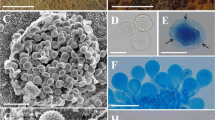Abstract
Preliminary investigations into the diversity of Puccinia boroniae, collected from across southern Western Australia, were conducted by morphological comparison of the teliospores derived from host species Boronia heterophylla and Boronia megastigma, and by restriction enzyme profiling of the internal transcribed spacer (ITS) region of the nuclear rRNA (rRNA) genes of 21 isolates from a variety of different Boronia species and cultivars. Assessment of teliospore morphology provided significant evidence of two distinct rust groups, separated on the basis of their host plant origin. In general, teliospores from Boronia heterophylla had wider apical and basal cell widths, thinner cell walls and apical papilla, than those isolated from Boronia megastigrna. Restriction analysis of the ITS region provided no evidence of intraspecific variation among the 21 isolates; however, one isolate, distinct from the screened population both geographically and by host origin, was shown to have a length variation (insertion) within the ITS region amplified by PCR. The results indicate that subgroups of P. boroniae in Western Australia may be present, with further evidence required to define the level of separation in the population.
Similar content being viewed by others
References
Adam DB (1932) Rust disease in Boronia. Journal of Agriculture. Victoria 30, 389–391.
Anon. (2001) ‘Australian native and South African species cultivated for the export cutflower industry of Western Australia. Planting and production results of the 1999 survey.’ (Department of Agriculture: Perth, WA)
Anikster Y (1986) Teliospore germination in some rust fungi. Phytopathology 76, 1026–1030.
Ankister Y, Bushneil WR, Eilam T, Manisterski J, Roelfs AP (1997) Puccinia recondita causing leaf rust on cultivated wheats, wild wheats, and rye. Canadian Journal of Botany 75, 2082–2096.
Berthier YT, Bruckart WL, Chaboudez P, Luster DG (1996) Polymorphic restriction patterns of ribosomal internal transcribed spacers in the biocontrol fungus Puccinia carduorum correlate with weed host origin. Applied and Environmental Microbiology 62, 3037–3041.
Bruns TD (2001) ITS reality. Inoculum. Newsletter of the Mycological Society of America 52, 3–4.
Dunne CP, Glen M, Tommerup IC, Shearer BL, Hardy GESJ (2002) Sequence variation in the rDNA ITS of Australian Armillaria species and intra-specific variation in A. luteobubalina. Australasian Plant Pathology 31, 241–251.
Edwards J, Ades PK, Parbery DG, Halloran GM, Taylor PWJ (1999) Morphological and molecular variation between Australian isolates of Puccinia menthae. Mycological Research 103, 1505–1514.
Egger KN (1995) Molecular analysis of ectomycorrhizal fungal communities. Canadian Journal of Botany 73, S1415-S1422.
Gardes M, Brans T (1996) ITS-RFLP matching for identification of fungi. In ‘Species diagnostics protocols: PCR and other nucleic acid methods’. (Ed. JT Clapp) pp. 177–186. (Humana Press Inc.: Totowa)
Harrington TC, Rizzo DM (1999) Defining species in the fungi. In ‘Structure and dynamics of fungal populations’. (Ed. JJ Worrall) pp. 43–71. (Kluwer Press: Dordrecht)
Hennings P (1903) Puccinia boroniae. Hedwigia 42, 73.
Kropp BR, Hansen DR, Wolf PG, Flint KM, Thomson SV (1997) A study on the phylogeny of the dyers woad rust fungus and other species of Puccinia from crucifers. Phytopathology 87, 565–571.
Liu Z, Szabo LJ, Bushnell WR (1993) Molecular cloning and analysis of abundant and stage-specific mRNAs from Puccinia graminis. Molecular Plant-Microbe Interactions 6, 84–91.
Matsumoto C, Kageyama K, Suga H, Hyakumachi M (2000) Intraspecific DNA polymorphisms of Pythium irregulare. Mycological Research 104, 1333–1341.
McAlpine D (1906) ‘The rusts of Australia: their structure, nature, and classification.’ (Government Printer: Melbourne)
Sambrook J, Fritsch EF, Maniatis T (1989) ‘Molecular cloning: a laboratory manual.’ (Cold Spring Harbor Laboratory Press: Cold Spring Harbor, New York)
Statsoft (1995) ‘Statistica for Windows: general conventions and statistics I.’ (Statsoft: Tulsa Oklahoma)
Stewart CN (1997) RapidDNA extraction from plants. In ‘Fingerprinting methods based on arbitrarily primed PCR’. (Eds MR Micheli, R Bova) pp. 25–28. (Springer Verlag: Berlin)
White TJ, Bruns T, Lee S, Taylor J (1990) Amplification and direct sequencing of fungal ribosomal RNA genes for phylogenetics. In ‘PCR protocols: a guide to methods and applications’. (Eds MA Innis, DH Gelfand, JJ Sninsky, TJ White) pp. 315–322. (Academic Press: San Diego)
Author information
Authors and Affiliations
Corresponding author
Rights and permissions
About this article
Cite this article
Driessen, S.A., O’Brien, P.A. & Hardy, G.E.S.J. Diversity of Puccinia boroniae assessed by teliospore morphology and restriction fragment patterns of ribosomal DNA. Australasian Plant Pathology 33, 77–82 (2004). https://doi.org/10.1071/AP03091
Received:
Accepted:
Issue Date:
DOI: https://doi.org/10.1071/AP03091




